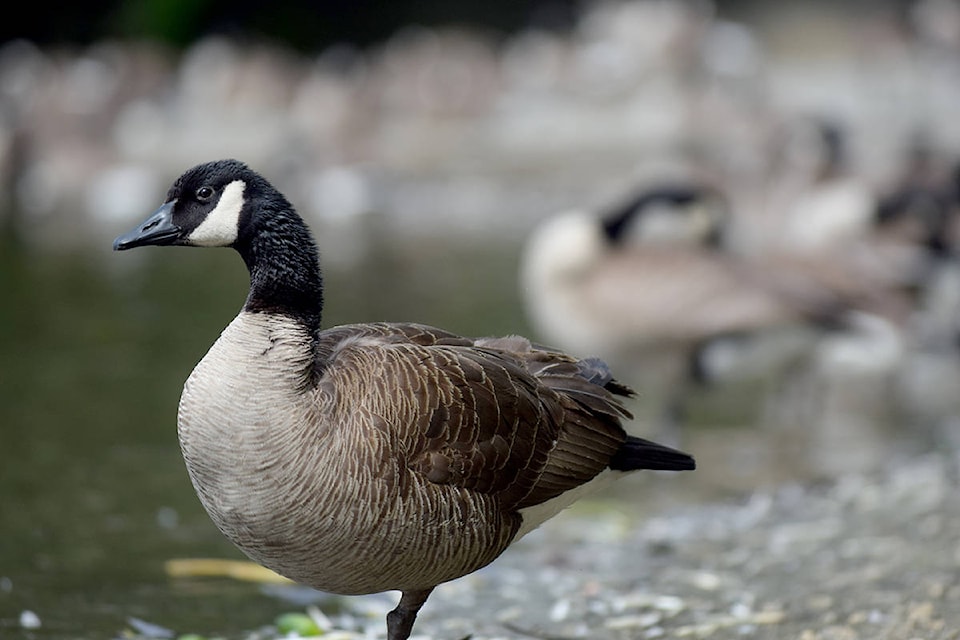Linda Geggie
For the Saanich News
Saanich council recently responded with a measured yet unanimous yes, to a motion put forward by Coun. Fred Haynes, to take further steps to control Canada geese populations in Saanich. There are an estimated 6,000 resident, non-migratory geese in the CRD and it is forecasted that these numbers will grow to 60,000 in the next 20 years. In May of this year the Peninsula and Area Agriculture Commission reached out to local governments requesting amendments to the Migratory Bird Act to address the expanding resident non-migratory Canada geese populations, and asked “to make it easier for local jurisdictions to manage the populations, thereby reducing the continual damage to agricultural crops, improve food security and the health and safety of our beaches, parks and waterways.”
“If we want local food, and we say we do, farmers on the peninsula need our clear and firm support on taking actions to resolve the unsustainable predation of their crops by the exploding populations of non-migratory geese and deer” stated Councillor Haynes, in a letter to fellow councillors. “Their livelihood and our options for local food are being seriously damaged.” Haynes believes that “Given that the District of Saanich is both an urban and rural municipality, careful consideration of the implications of any amendment to the firearms bylaw is necessary.” Council agreed.
CRD director Mike Hicks developed the model motion that was put forward. It called for “Any landowner or nominee with a current Canadian Wildlife Service Crop Protection permit may hunt on their permitted lands using the federal migratory birds regulations and in possession of a valid federal migratory game bird hunting permit.”
From what I understand, what this would allow is for the expansion of an already approved method of reducing Geese populations, but have more impact. In his letter to Saanich council, Hicks explains that Metchosin, Saanich, Central Saanich, North Saanich, the Juan de Fuca Electoral Area, Salt Spring and the Gulf Islands currently allow limited hunting of geese for those farms who have obtained a crop damage permit. The two-year permits are issued to qualified farms that are required to register their hunters and abide by the regulations set by the local police and municipality. Crop damage permits allow for the hunting of between five and 10 birds per week. Hunters are not allowed to use blinds or decoys and are forbidden from eating the geese.
Hicks state that this permitted activity was intended to scare away or “haze” geese, not to have an impact on flock numbers. The new firearms bylaw would allow hunting to take place on farms that have obtained a crop damage permit from the Federal Government’s Canadian Wildlife Service as before but would now allow in addition to their total of five geese per week, to use blinds and decoys and take 10 geese per day per hunter. Importantly states Hicks, “They would also be permitted to keep and eat these beautiful birds.” The restrictions imposed by the Wildlife Service and Crop Protection Permit would “remain the same, the hunters would remain the same but the total number of geese would be dramatically reduced.”
It is important to note that this bylaw only impacts Non-migratory resident Canada geese who are not native to the island. These birds were introduced from Eastern Canada in the ’60s and ’70s for wildlife viewing and hunting. Since this time with plenty of forage and a lack of predators, this population has grown and is having impacts on food production. It is not intended to affect native migratory Canada geese who are only present in the spring and fall.
While most farmers will tell you that geese are chewing through their profits, not all farmers agree with culling as the primary approach to dealing with the issue. There are other ways of managing geese populations and some farmers would rather see a focus on those methods. Egg addling (or shaking) the eggs of geese in the spring is another approach that has been put into play as part of the efforts of the CRD’s Regional Goose Management Strategy. This program was initiated but advocates say it would need to happen on a much greater scale to have considerable impacts. Other farmers say we need to learn to live with the geese. Natalie Chambers of Madrona Farm has developed methods in their farming practices to work with the geese. This includes discouraging them from landing on the fields by stringing twine in trees when their crops are tender, and in planting cover crops that draw the birds away from chowing down on their fruits and vegetables.
Whatever approach you think is important the one thing that is clear is that we do have a challenge on our hands for local food producers. When humans tinker with ecosystems, as we do, there are implications that we must deal with and they can be complex and polarizing. While choosing to support the culling of geese may be politically and ethically challenging, the motion passed by Saanich council is encouraging in that it sends a clear message that local food is important, and that they are listening to farmers and stepping up to support them.
Linda Geggie is the executive director with the Capital Region Food and Agriculture Initiatives Roundtable and can be reached at lgeggie@cfair.ca.
